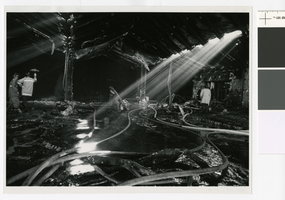Search the Special Collections and Archives Portal
Search Results

Photograph of a floating craps game in the Sands Hotel swimming pool (Las Vegas), 1954
Date
Archival Collection
Description
Guests at the Sands playing craps on a floating table in the pool. Transcribed from photo sleeve: "Floating craps table - Customers at the Sands Hotel escape the heat by gambling in the pool. About 2200 guests tried this in 1954." Stamped on original: "Desert Sea News Bureau. Las Vegas, Nevada. Photo by Don English - Dave Lees - Joe Buck."
Site Name: Sands Hotel
Address: 3355 Las Vegas Boulevard South
Image

Photograph of the Union Plaza a month after opening (Las Vegas), 1971
Date
Archival Collection
Description
View of the newly completed Union Plaza. Transcribed from photo sleeve: "Aerial view of the completed Union Plaza Hotel & Casino. The Las Vegas freeway and Union Pacific Railroad in the background. Aug. 3, 1971." Stamped on original: "Union Pacific Photo Division - Public Relations. 5480 Ferguson Dr., Los Angeles, CA 90022. Aug 3 1971"
Site Name: Union Plaza
Address: 1 South Main Street
Image

Photograph of a quarter horse sale on Fremont Street (Las Vegas), April 17, 1968
Date
Archival Collection
Description
Horse sale on Fremont Street at night, showing the neon of the Mint, Horseshoe, and Hotel Fremont, all of which make up part of Glitter Gulch. Stamped on original: "Allen Photographers, Inc. Post Office Box 4253 Las Vegas, Nevada 89106."
Site Name: Fremont Street
Address: Fremont street, Las Vegas, NV
Image

Photograph of the Horseshoe Hotel & Casino at night (Las Vegas), 1960s
Date
Archival Collection
Description
Night view of the Horseshoe Hotel and Casino. Stamped on original: "Jay Florian Mitchell. Photographer. 614 So. 6th DU 4-5148 Las Vegas, Nevada. Douglass Studio, Inc. 614 South Sixth. Dudley 4-5148. Las Vegas, Nevada."
Site Name: Horseshoe Club
Address: 128 East Fremont Street
Image

Architectural drawing of Holiday Casino(Las Vegas), proposed master plan looking north, 1976
Date
Archival Collection
Description
Conceptual drawing of the proposed Holiday Casino, now Harrah's. Transcribed from photo sleeve: "Martin Stern's proposed master plan for the tower expansion of the Las Vegas Holiday Inn, now Harrah's."
Site Name: Holiday Casino
Address: 3475 Las Vegas Boulevard South
Image

Photograph of Fremont Street from the Union Plaza (Las Vegas), circa 1970s
Date
Archival Collection
Description
Looking east down Fremont Street from the pool in front of the Union Plaza in the 1970s. Stamp on back of photo: "Las Vegas News Bureau, Convention Center, Las Vegas, Nevada, 25655, Don English, Jim Vorrup, Jerry Abbott, Joe Buck, Gary Angell, Tony King, Milt Palmer, Wolf Wergin, Lee McDonald, Herb Herpolsheimer."
Site Name: Union Plaza
Address: 1 South Main Street
Image

Photograph of the "Welcome to Fabulous Las Vegas Nevada" sign, circa 1970s
Date
Archival Collection
Description
Welcome to Fabulous Las Vegas Nevada sign with the Hacienda in the background. Stamp on back of photo: "Las Vegas News Bureau, Convention Center, Las Vegas, Nevada, 25655, Don English, Jim Vorrup, Jerry Abbott, Joe Buck, Gary Angell, Tony King, Milt Palmer, Wolf Wergin, Lee McDonald, Herb Herpolsheimer."
Site Name: Las Vegas Strip
Address: Las Vegas Boulevard, Las Vegas, NV
Image

Photograph of gamblers at a baccarat table in the Sahara Hotel and Casino (Las Vegas), circa 1970s
Date
Archival Collection
Description
Gamblers at a baccarat table in the Sahara Casino. Stamp on back of photo: "Las Vegas News Bureau, Convention Center, Las Vegas, Nevada, 25655, Don English, Jim Vorrup, Jerry Abbott, Joe Buck, Gary Angell, Tony King, Milt Palmer, Wolf Wergin, Lee McDonald, Herb Herpolsheimer."
Site Name: Sahara Hotel and Casino
Address: 2535 Las Vegas Boulevard South
Image

Photograph of the aftermath of the MGM Grand Hotel fire (Las Vegas), circa November, 1980
Date
Archival Collection
Description
Interior view of fire damaged MGM Grand. Stamp on back of photo: "R-J Photo by Scott Henry." The MGM Grand Hotel was re-built in 1981 and sold to Bally's Corporation to become Bally's Las Vegas in 1985.
Site Name: MGM Grand Hotel
Address: 3645 Las Vegas Boulevard South, Las Vegas, NV
Image

Photograph of the Chuck Wagon Buffet at the El Rancho Vegas (Las Vegas), late 1940s
Date
Archival Collection
Description
Two cooks standing ready for diners at the Chuck Wagon Buffet at the El Rancho Vegas. Stamp on back of photo: "Las Vegas News Bureau, Las Vegas-Nevada, Photographers Don English, Joe Buck, Jerry Abbott, 0791."
Site Name: El Rancho Vegas
Address: 2500 Las Vegas Boulevard South
Image
